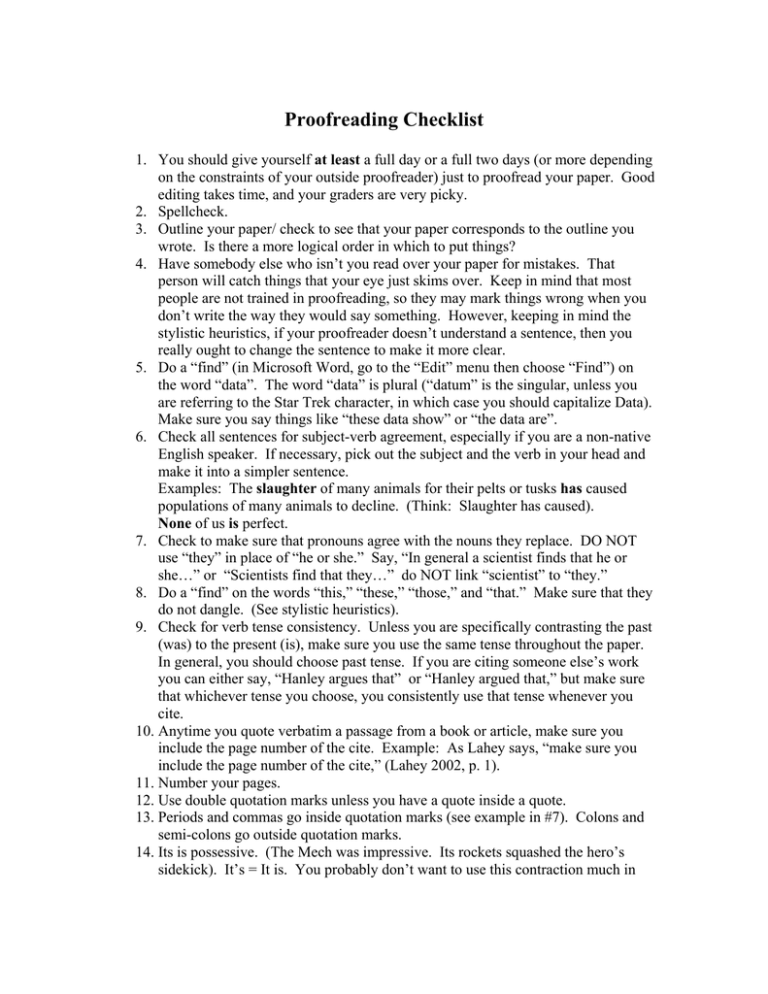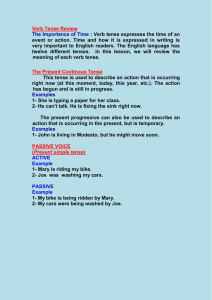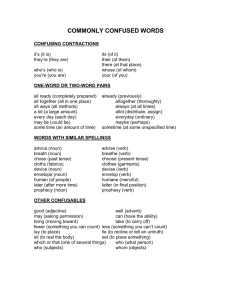Proofreading Checklist
advertisement

Proofreading Checklist 1. You should give yourself at least a full day or a full two days (or more depending on the constraints of your outside proofreader) just to proofread your paper. Good editing takes time, and your graders are very picky. 2. Spellcheck. 3. Outline your paper/ check to see that your paper corresponds to the outline you wrote. Is there a more logical order in which to put things? 4. Have somebody else who isn’t you read over your paper for mistakes. That person will catch things that your eye just skims over. Keep in mind that most people are not trained in proofreading, so they may mark things wrong when you don’t write the way they would say something. However, keeping in mind the stylistic heuristics, if your proofreader doesn’t understand a sentence, then you really ought to change the sentence to make it more clear. 5. Do a “find” (in Microsoft Word, go to the “Edit” menu then choose “Find”) on the word “data”. The word “data” is plural (“datum” is the singular, unless you are referring to the Star Trek character, in which case you should capitalize Data). Make sure you say things like “these data show” or “the data are”. 6. Check all sentences for subject-verb agreement, especially if you are a non-native English speaker. If necessary, pick out the subject and the verb in your head and make it into a simpler sentence. Examples: The slaughter of many animals for their pelts or tusks has caused populations of many animals to decline. (Think: Slaughter has caused). None of us is perfect. 7. Check to make sure that pronouns agree with the nouns they replace. DO NOT use “they” in place of “he or she.” Say, “In general a scientist finds that he or she…” or “Scientists find that they…” do NOT link “scientist” to “they.” 8. Do a “find” on the words “this,” “these,” “those,” and “that.” Make sure that they do not dangle. (See stylistic heuristics). 9. Check for verb tense consistency. Unless you are specifically contrasting the past (was) to the present (is), make sure you use the same tense throughout the paper. In general, you should choose past tense. If you are citing someone else’s work you can either say, “Hanley argues that” or “Hanley argued that,” but make sure that whichever tense you choose, you consistently use that tense whenever you cite. 10. Anytime you quote verbatim a passage from a book or article, make sure you include the page number of the cite. Example: As Lahey says, “make sure you include the page number of the cite,” (Lahey 2002, p. 1). 11. Number your pages. 12. Use double quotation marks unless you have a quote inside a quote. 13. Periods and commas go inside quotation marks (see example in #7). Colons and semi-colons go outside quotation marks. 14. Its is possessive. (The Mech was impressive. Its rockets squashed the hero’s sidekick). It’s = It is. You probably don’t want to use this contraction much in formal writing… contractions are often frowned upon and this contraction has a “to be” verb in it. 15. In the most common uses of the words, affect = verb (except in psychology) and effect = noun (except when used to mean “to bring about”) Ex: To truly affect one’s students one must carefully monitor the effects of one’s lecture. 16. lead = present tense; led = past tense. (Except when lead is a noun meaning a poisonous metal, and when LED is a noun meaning an electronic display). Other homonyms to watch out for include: there (opposite of here), their (possessive), they're (they are); to, too, two; your (possessive), you're (you are). Be especially careful about “to” vs. “too” (hint: too = also). Your spellchecker will not catch these, and you look uneducated if you accidentally use the wrong homonym in a formal paper. Also you should check for, “from” vs. “form” and other easy-tomake typographical errors. 17. Do a capitalization check. 18. Do a period check. 19. MAKE SURE EVERY IDEA THAT IS NOT YOUR OWN HAS A CITATION. Any time you state a fact, you MUST cite where you found that fact. Note that it is OK to not have a single idea of your own in the paper, so long as you critically compare and contrast arguments by scholars, just give credit so that your reader can look things up should he or she want to know more details. DO NOT PLAGIARIZE. 20. Check the spelling on the names of authors you cite. 21. Do a final read-through of your paper for cut and paste errors. Some people recommend starting at the bottom of the paper and reading sentence by sentence up to the top.






